“Way down South in the land of
cotton, old times there are not forgotten. Look away, look away,
look away Dixieland.” So go the opening lyrics of a song that
became the anthem of the American South and eventually the
Confederacy. The culture, everyday day life, and the Civil War were
all a result of a simple shrub that bore puffy white fruit—cotton.
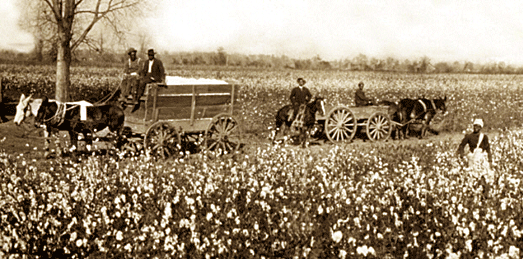
The ancients called it tree wool. Some held that it was the real
"golden fleece" sought by Jason the Argonaut. Historians believe the
people of India were the first to weave it into a fabric so delicate
that it disappeared when wet. Today, cotton is commonly available to
everyone, but back then it was so costly that only the wealthy could
afford to wear it.
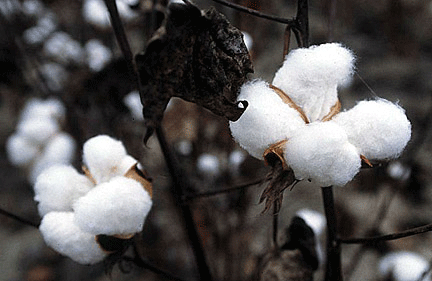 In
the Indus River Valley in Pakistan, cotton was being grown, spun and
woven into cloth 3,000 years BC. ... Arab merchants brought cotton
cloth to Europe about 800 A.D. When Columbus discovered America in
1492, he found cotton growing in the Bahamas. By 1500, cotton was
known generally throughout the world.
In
the Indus River Valley in Pakistan, cotton was being grown, spun and
woven into cloth 3,000 years BC. ... Arab merchants brought cotton
cloth to Europe about 800 A.D. When Columbus discovered America in
1492, he found cotton growing in the Bahamas. By 1500, cotton was
known generally throughout the world.
Cultivation of cotton as a true crop didn’t begin in America until
after the Revolutionary War, yet by the end of the 18th century,
demand exceeded production. American cotton production soared from
156,000 bales in 1800 to more than 4,000,000 bales in 1860—a bale is
a compressed bundle of cotton weighing between 400 and 500 pounds.
But growing and processing cotton was labor intensive. The seeds are
planted in spring and cotton plants grow into green, bushy shrubs
about three feet high. The plants briefly grow pink and cream
colored flowers that once pollinated, drop off and are replaced with
“fruit”, better known as cotton bolls. For every five bales turned
out by one man in a season, 12 hours a day would be spent separating
seeds from the filament.
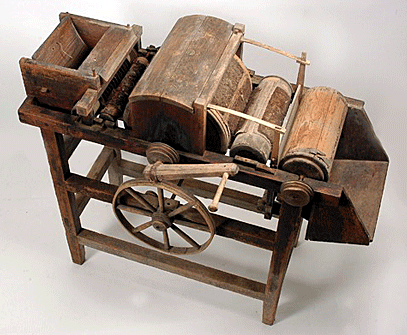 Eli
Whitney solved this problem in 1793 and cotton production rose from
487,000 pounds to 6.200.000 pounds in just three years, triggering;
a manufacturing and social upheaval. By the early 1830s, the United
States produced the majority of the world’s cotton.
Eli
Whitney solved this problem in 1793 and cotton production rose from
487,000 pounds to 6.200.000 pounds in just three years, triggering;
a manufacturing and social upheaval. By the early 1830s, the United
States produced the majority of the world’s cotton.
When America became the main supplier for English textile mills, the
need for both plantations and the slaves to work them grew. Before
the American Civil War, cotton produced in the American South had
accounted for 77 percent of the 800 million pounds of cotton used in
Great Britain. In the North large processing centers employing the
latest machines were established in New England, resulting in a drop
in prices that increased demand further. At the time, the the
economy seemed to revolve around cotton.
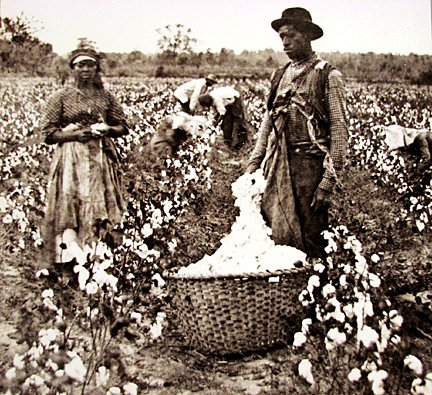 Cultivation
of cotton using black slaves brought huge profits to the owners of
large plantations, making them some of the wealthiest men in the
U.S. prior to the Civil War. In the non-slave-owning states, farms
rarely grew larger than what could be cultivated by one family due
to scarcity of farm workers. In the slave states, owners of farms
could buy many slaves and thus cultivate large areas of land. By the
1850s, slaves made up 50% of the population of the main cotton
states: Georgia, Alabama, Mississippi, and Louisiana. Slaves were
the most important asset in cotton cultivation, and their sale
brought profits to slave owners outside of cotton-cultivating areas.
Thus, the cotton industry contributed significantly to the Southern
upper class's support of slavery.
Cultivation
of cotton using black slaves brought huge profits to the owners of
large plantations, making them some of the wealthiest men in the
U.S. prior to the Civil War. In the non-slave-owning states, farms
rarely grew larger than what could be cultivated by one family due
to scarcity of farm workers. In the slave states, owners of farms
could buy many slaves and thus cultivate large areas of land. By the
1850s, slaves made up 50% of the population of the main cotton
states: Georgia, Alabama, Mississippi, and Louisiana. Slaves were
the most important asset in cotton cultivation, and their sale
brought profits to slave owners outside of cotton-cultivating areas.
Thus, the cotton industry contributed significantly to the Southern
upper class's support of slavery.
Secure in their importance, Southern planters defied the world to
restrict their rights. "You dare not make war upon cotton; no power
on earth dare make war upon it. Cotton is king:" Senator James
Hammond of South Carolina declared before the Civil War proved him
wrong.
Cotton wasn’t simply a Southern phenomenon. Cotton was one of the
world’s first luxury commodities, after sugar and tobacco, and was
also the commodity whose production most dramatically turned
millions of black human beings in the United States themselves into
commodities. Cotton became the first mass consumer commodity.
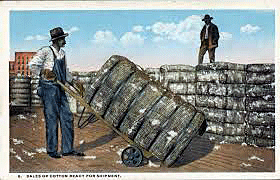 So
interconnected and overlapping were the economies of the cotton
plantation, the Northern banking industry, New England textile
factories and a huge proportion of the economy of Great Britain
helps us to understand why it was something of a miracle that
slavery was finally abolished in this country at all. New England
mills consumed 283.7 million pounds of cotton, or 67 percent of the
422.6 million pounds of cotton used by U.S. mills in 1860.” In other
words, on the eve of the Civil War, New England’s economy, so
fundamentally dependent upon the textile industry, was inextricably
intertwined, as Bailey puts it, “to the labor of black people
working as slaves in the U.S. South.
So
interconnected and overlapping were the economies of the cotton
plantation, the Northern banking industry, New England textile
factories and a huge proportion of the economy of Great Britain
helps us to understand why it was something of a miracle that
slavery was finally abolished in this country at all. New England
mills consumed 283.7 million pounds of cotton, or 67 percent of the
422.6 million pounds of cotton used by U.S. mills in 1860.” In other
words, on the eve of the Civil War, New England’s economy, so
fundamentally dependent upon the textile industry, was inextricably
intertwined, as Bailey puts it, “to the labor of black people
working as slaves in the U.S. South.
Therefore, the ultimate cause of the Civil War was King Cotton.

After Reconstruction, cotton resumed
its throne, despite a new social order that forced plantation owners
to deal with their workers on a business basis. It was still a year
long, labor-intensive pursuit. In January, fields were cleared of
the old stalks. February was a month for repair of fences and
farming implements. Plowing and planting was done in March. Plants
appeared in April, triggering the never-ending work of keeping
weeds, worms and weevils at bay.
By July, the plants were tall and "water furrows" were plowed deep
for the rainy season of rust and rot. The first bolls were ready for
picking by the end of the month and continued ripening up until the
Christmas holidays. Ginning and baling was done throughout the
picking season.
More than ever, cotton seemed to be king. By 1878, America boasted
at least1,000 large factories engaged in the spinning, weaving,
finishing, dyeing and decorating of cotton cloth, yarns and thread
by the latest and most efficient machines. Cotton fabrics had become
a necessity of American life, used in bedding, underwear, white
shirts, cotton flannels and the waists and summer dresses of women.
Only thread sold in greater quantity.
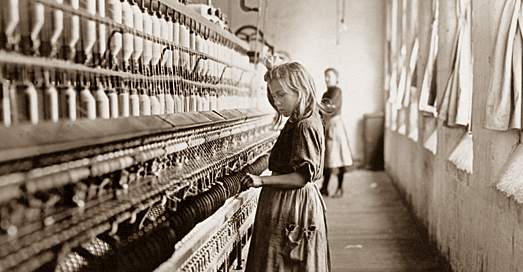
The largest of the thread mills at Willimantic, Conn., turned out
4,000 pounds of thread a day at. top capacity, and the country
turned out an estimated total of 149,000,000 pounds of threads,
yarns and twine in 1874. Thread companies flourished, each flaunting
the superior quality of their product through imaginative
advertising. One of the features at the 1884 New Orleans Exposition
was a representation of the old tower at Newport in spools of thread
– a fitting symbol of the lengths to which manufacturers would go to
promote their wares.
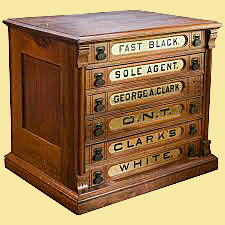 Collectors
prize spool cabinets that both advertised and housed a company's
thread in stores all over America, paying from $200 to more than
$1,000 depending on style and condition. Some were simple two-drawer
chests with plain paper labeling. Others featured glass-insert
drawers and lift-tops. The best were self-contained desk-types that
could classify as furniture. Even wooden thread spools are
collected. Prices run from $2-3 each if the logo is intact and some
of the original thread remains. Empty wooden spools with no brand
sell two or three for $1 at most flea markets.
Collectors
prize spool cabinets that both advertised and housed a company's
thread in stores all over America, paying from $200 to more than
$1,000 depending on style and condition. Some were simple two-drawer
chests with plain paper labeling. Others featured glass-insert
drawers and lift-tops. The best were self-contained desk-types that
could classify as furniture. Even wooden thread spools are
collected. Prices run from $2-3 each if the logo is intact and some
of the original thread remains. Empty wooden spools with no brand
sell two or three for $1 at most flea markets.
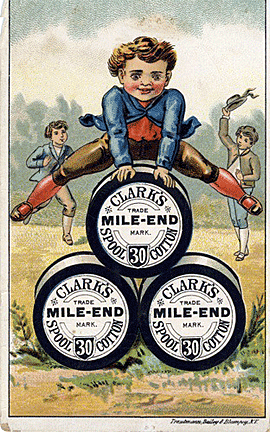 Fortunately
for those on a budget, thread companies issued thousands of colorful
advertising trade cards that survive in surprising numbers. Prices
for these range from $5-15, depending on quality, image and
condition. As with other trade cards, common images and scenics
bring the least. Blacks pictured on any card drive prices up from
$15-35, however, and any depiction of cotton picking – whether the
product being advertised is related or not – guarantees collector
interest.
Fortunately
for those on a budget, thread companies issued thousands of colorful
advertising trade cards that survive in surprising numbers. Prices
for these range from $5-15, depending on quality, image and
condition. As with other trade cards, common images and scenics
bring the least. Blacks pictured on any card drive prices up from
$15-35, however, and any depiction of cotton picking – whether the
product being advertised is related or not – guarantees collector
interest.
Mass-produced souvenir postcards are the exception, and a view of
fields full of pickers or of cotton bales stacked on a wharf is
unlikely to bring more than $1-3 unless early and unusual. Real
photo post-cards of limited production generate enough excitement to
earn $15-35, while actual photographs can soar into three figures if
early enough and desirable enough.
Prints, advertising signs and product containers that find a reason
to represent cotton picking or the handling of bales are sought by
collectors of black Americana. There is also a great deal of
interest and curiosity about early cotton plantations – a curiosity
that was shared by the Victorians and resulted in occasional
articles on the subject in publications of the time.
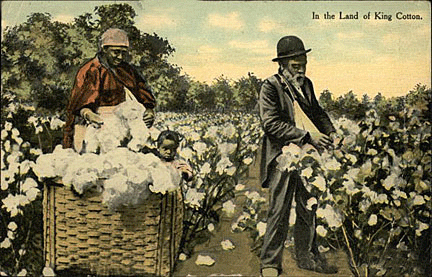
King Cotton had been nearly dethroned by the time of the 1884 New
Orleans "Cotton" Exposition. In fact, the organizers actually struck
from the title and purpose of the fair. Corn, some proclaimed, was
the true king. Westward expansion after the Civil War had changed
everything but the continuing usefulness of cotton. Applications
were found for its seeds. and their oil. Even the stalk proved to be
excellent thatch and basket fiber. And who can think of that time
without an image of airy white cotton dresses floating across the
perfect green lawn of a Victorian summer day?
